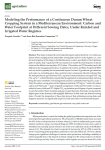Garofalo P., Cammerino A.R. (2025). Modeling the performance of a continuous durum wheat cropping system in a mediterranean environment: carbon and water footprint at different sowing dates, under rainfed and irrigated water regimes. Agriculture, 01/02/2025, vol. 15, n. 3, p. 259.
https://doi.org/10.3390/agriculture15030259
https://doi.org/10.3390/agriculture15030259
| Titre : | Modeling the performance of a continuous durum wheat cropping system in a mediterranean environment: carbon and water footprint at different sowing dates, under rainfed and irrigated water regimes (2025) |
| Auteurs : | P. Garofalo ; A.R. Cammerino |
| Type de document : | Article |
| Dans : | Agriculture (vol. 15, n. 3, February 2025) |
| Article en page(s) : | p. 259 |
| Langues : | Anglais |
| Langues du résumé : | Anglais |
| Catégories : |
Catégories principales 06 - AGRICULTURE. FORÊTS. PÊCHES ; 6.5 - Gestion des ExploitationsThésaurus IAMM SYSTEME DE CULTURE ; MODELE ; PERFORMANCE DE CULTURE ; BLE DUR ; CEREALICULTURE ; REGION MEDITERRANEENNE ; ITALIE |
| Résumé : | This study evaluates the environmental impacts and productivity of a continuous durum wheat cropping system under three sowing dates and two water regimes, i.e., rainfed and irrigation at flowering in the Mediterranean context, specifically in the Capitanata plain of Apulia, Italy. AquaCrop-GIS was employed to model the yield response of durum wheat on the different sowing dates (15 October, 1 November, and 15 November) and with different water management practices. In addition, the Carbon and Water Footprint (CWFP) tool was used to quantify the environmental impacts in terms of greenhouse gas emissions and water use, including green, blue, and total water components. Results indicated that the total greenhouse gas emissions (CO2_eq) from wheat production averaged 1201.3 kg CO2_eq ha−1, with fertilization, in particular the application of ammonium nitrate and urea, being the main contributor. Soil management practices contributed 362.9 kg CO2_eq ha−1. Early-November sowing achieved the highest productivity, 5573 kg ha−1 under the rainfed option and 5722 kg ha−1 under irrigated management, while mid-November sowing resulted in lower yields and 21% higher CO2_eq emissions per kilogram of grain compared to early November. Water Footprint analysis revealed that early-November sowing had the highest green water demand, with negligible differences in blue water use between sowing dates. Overall, the integration of these data showed that optimizing sowing dates and irrigation practices can significantly improve yields and reduce environmental impacts. |
| Cote : | En ligne |
| URL / DOI : | https://doi.org/10.3390/agriculture15030259 |







